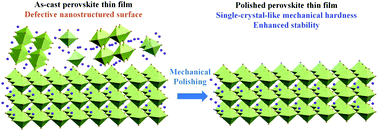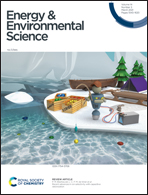Revealing defective nanostructured surfaces and their impact on the intrinsic stability of hybrid perovskites†
Abstract
The instability of metal halide perovskites (MHPs) remains to be one major obstacle for the commercialization of perovskite solar cells. Here we report the observation of nanocrystals and some amorphous phases at the surface of apparent single crystalline grains in polycrystalline films deposited by almost all known solution deposition methods, which accelerate the degradation of MHPs. By removing the defective surface layer through mechanical polishing, the stability of perovskite films is significantly enhanced. Encapsulated solar cells based on polished MHPs retain 93% of their initial efficiency after continuous illumination for 2180 hours at 1 sun intensity and with ultraviolet radiation at 65 °C. Removing the defective surface layers restores the mechanical hardness to be comparable to that of single crystals, which suppresses ion migration and permeation of detrimental species into perovskite grains. This study narrows down the stability gap between the MHP polycrystalline films and single crystal perovskites which represents the upper limit for the stability of MHPs.



 Please wait while we load your content...
Please wait while we load your content...
